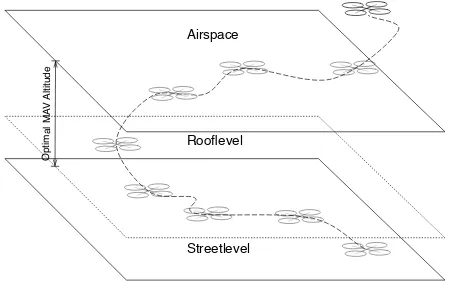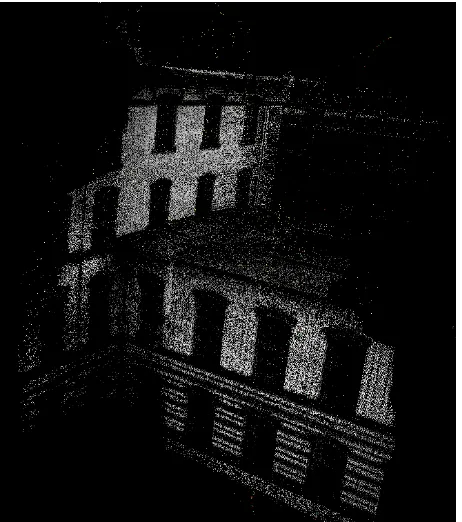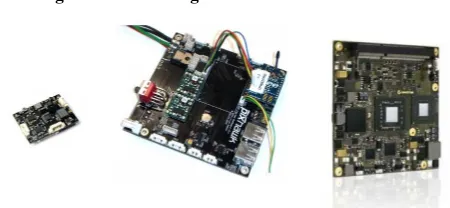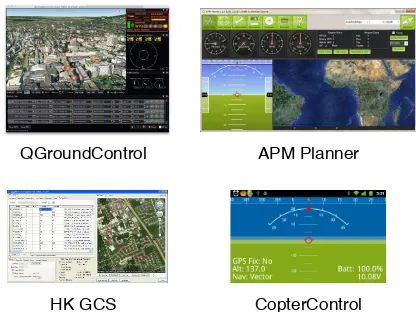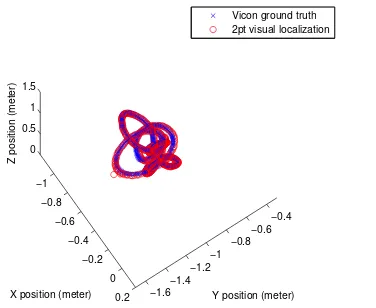THE PIXHAWK OPEN-SOURCE COMPUTER VISION FRAMEWORK FOR MAVS
Lorenz Meier and Petri Tanskanen and Friedrich Fraundorfer and Marc Pollefeys
Institute for Visual Computing, Computer Vision and Geometry Lab Swiss Federal Institute of Technology / ETH Zurich
CAB G 86.3, Universitaetstrasse 6, 8092 Zurich
lm@inf.ethz.ch, tpetri@inf.ethz.ch, fraundorfer@inf.ethz.ch, pomarc@inf.ethz.ch http://www.cvg.ethz.ch
KEY WORDS:UAVs, MAVs, computer vision, open source, middleware, hardware
ABSTRACT:
Unmanned aerial vehicles (UAV) and micro air vehicles (MAV) are already intensively used in geodetic applications. State of the art autonomous systems are however geared towards the application area in safe and obstacle-free altitudes greater than 30 meters. Applications at lower altitudes still require a human pilot. A new application field will be the reconstruction of structures and buildings, including the facades and roofs, with semi-autonomous MAVs. Ongoing research in the MAV robotics field is focusing on enabling this system class to operate at lower altitudes in proximity to nearby obstacles and humans. PIXHAWK is an open source and open hardware toolkit for this purpose. The quadrotor design is optimized for onboard computer vision and can connect up to four cameras to its onboard computer. The validity of the system design is shown with a fully autonomous capture flight along a building.
1 INTRODUCTION
Already today UAVs and MAVs play a big role in photogram-metric and geodetic applications (Eisenbeiss, 2009, Eisenbeiss et al., 2005). While the larger Unmanned Air Vehicles are typically used in environments in the square kilometer range, Micro Air Vehicles are more suitable for smaller areas or urban environ-ments. One of the main applications is the generation of aerial imagery for digital elevation model (DEM) generation, ortho-photo generation and 3D reconstruction and modeling. Com-pared to standard aerial imaging these small-scale flying vehi-cles offer new and unconventional camera viewpoints and more closeup views. This makes it easier to fuse street-level imagery and aerial-imagery to use both sources to create complete 3D models of buildings. In addition to these well known photogram-metric application new industrial applications start to emerge as well. MAVs can provide easy access for visual inspections of high rising industrial structures and plants. Road inspection and traffic analysis are other application fields that are also well suited for UAVs or MAVs (Zhang, 2008, Mori et al., 1996). Envi-ronmental monitoring in general holds big application areas for UAVs and MAVs. In particular if the UAVs fly autonomously and are able to perform the monitoring fully automatic. One big appli-cation area to come is the use of UAVs and MAVs to aid in emer-gency response (Choi et al., 2009, Haarbrink and Koers, 2006). They could provide aerial views of the catastrophe scene which allows the first responders to efficiently manage their efforts. This however would require fully autonomous MAVs that are easy to handle and do not require trained operators. Autonomous flight would be most beneficial for all the other application areas as well. The need for trained operators limits the application ar-eas severely and thus this should be one of the top priorities of MAV research. Many application areas would already heavily benefit from semi-automatic flight, such that not trained person-nel can fly the MAVs. Such semi-automatic MAVs would at least be able to hover on spot without input, perform a safe landing au-tonomously and are able to detect obstacles to prevent the opera-tor from crashing the MAV. One such example are archeological applications where the system would be operated by non-trained personnel (Oczipka et al., 2009, Sauerbier and Eisenbeiss, 2010). For applications in open areas GPS can be used to solve many
problems of autonomous flight, however small scale MAVs also allow indoor operation (e.g. for as built documentations of facili-ties) and for such applications different methodologies than GPS need to be developed. This applies also to outdoor applications where fully autonomous or semi-autonomous data capturing is necessary, but GPS reception is weak (Irschara et al., 2010).
Rooflevel
Streetlevel Airspace
O
p
ti
ma
l
MA
V
Al
ti
tu
d
e
Figure 1: Optimal MAV operational altitude between street level and roof level. This range is not accesible for UAVs or hand-held cameras.
1.1 MAV specific capabilities
In contrast to larger UAVs, MAVs can operate in a lower altitude range and closer to buildings and installations. On the opera-tional level, their substantially reduced weight and kinetic energy in case of system or operator failures is a very important prop-erty for the use of this system class in urban environments. This allows these systems to relatively easily cover the street-to-roof altitude range, as shown in Fig. 1. Current systems however require a very skilled pilot to be able to operate safely in urban environments. Adding onboard processing capabilities and stereo vision to the system allows it to not only fly a predefined course, but to also autonomously detect and avoid obstacles. This will be a critical step to enable full autonomous data capture by untrained operators.
high-resolution 3D reconstruction of individual buildings and eventu-ally of whole cities. Any ground-based capturing device would not be fast and flexible enough for this task and UAVs cannot reach the required view points. Fig. 2 shows the output of a MAV flight in the street-to-roof altitude range. The reconstruc-tion includes the facade and roof at high resolureconstruc-tion.
Figure 2: Sparse 3D reconstruction from flight images. Note that for the reconstruction of the facade and roof a MAV is necessary, as UAVs or ground-based cameras cannot reach these viewpoints.
1.2 Towards semi-autonomous data capture
The fully autonomous vision-based operation of a MAV is still ongoing research. With the availability of strong and lightweight onboard computers it became however feasible to add a certain level of autonomy to a MAV. Computer-vision based localization techniques outperform GPS at low altitudes and perform well in urban-canyon like scenarios where reflections lead to a reduced GPS accuracy. Even in the absence of sufficient visual cues and texture vision-based techniques can perform well, by placing a low quantity of artificial markers on the ground. Onboard stereo cameras help to evade nearby obstacles and can enable the MAV to autonomously adjust its surface distance to reach the desired image ground resolution. All these steps will allow MAVs to be used by untrained operators soon. Fig. 3 shows the concept of a semi-autonomous capture flight with an operator- defined tra-jectory. The MAV performs autonomous obstacle avoidance to recover from suboptimal user input. Additional aids in form of artificial visual markers can be provided in challenging environ-ments and critical flight phases, such as during takeoff and land-ing.
2 RELATED WORK
Several open source frameworks exist for micro air vehicles and ground robots. While the MAV frameworks are focused mostly on flight control and do not provide any significant robotics in-frastructure, the ground robot toolkits assume an Ethernet-based connection to all onboard components. The Paparazzi project was already used in photogrammetry to capture data sets on MAVs
Landing Pad with Markers Captured
Object
Evaded Obstacle
Figure 3: Concept showing MAV performing a semi-autonomous capture flight with user-defined trajectory, starting / landing aids and autonomous obstacle avoidance during flight.
(Jensen et al., 2008). Although the software can be run also on Linux, the toolkit is however geared towards the flight con-trol of the UAV and does not provide any image processing or mapping infrastructure. The OpenPilot project1 is a relatively
new open source toolkit for micro air vehicles, currently solely used on microcontrollers without any computer-connection op-tion. Ground robotics toolkits offer a very wide range of sensor drivers and computer vision and simultaneous localization and mapping (SLAM) packages. Their communication infrastructure does however require all components to support either TCP/IP or UDP connections. CLARAty (Volpe et al., 2001) and shortly after CARMEN (Montemerlo et al., 2003) were very early toolk-its paving the way for standardization in robotics. Since ROS (Quigley et al., 2009) was released more recently, their use has declined. ROS has been adopted on micro air vehicles. It requires however bridge processes for the communication to the onboard autopilot and external radio modems.
3 OPEN SOURCE SYSTEM DESIGN
The PIXHAWK MAV toolkit is geared towards computer-vision enabled MAVs. It facilitates the interfacing of cameras and au-topilots and provides a graphical user interface for the ground control station. This setup allows to quickly develop computer-vision enabled systems handling up to four cameras in parallel. By synchronizing the cameras with a hardware-shutter to the in-ertial measurement unit, all camera images are available synchro-nized and annotated with inertial and GPS information. This al-lows to employ new localization algorithms which exploit the additional information in the image. As computer-vision-based localization techniques typically have a relatively long and vary-ing processvary-ing time dependvary-ing on the current image content, the position estimator has to account for this variable delay. The at-titude sensors on the inertial measurement unit have however vir-tually zero delay and a constant processing time. All estimation and control software components are implemented on the low-level ARM7 autopilot and all computer vision algorithms on the high-level image processing computer. This design allows to use a standard GNU/Linux (Ubuntu) operating system on the high-level computer, while the system does not lose any of its real-time properties. Our natural feature based monocular localization technique is able to determine the system position at about 10-15 Hz using only one of the two cores of the onboard computer.
3.1 Data synchronization and time stamping
If vision data is used the position estimation and control steps cannot rely on a fixed time interval between the position updates.
Instead the system has to be able to cope with substantially dif-fering intervals and should be able to measure the delay between image capture to localization output. Therefore the system times-tamps all measurements and synchronizes them with microsec-onds resolution. This includes images from multiple cameras, data from the inertial measurement unit (system attitude, acceler-ation, barometric pressure) and GPS position.
As a result of the precise time-stamping and the following syn-chronization of the different data sources every image taken by the system is extended with the full state at the very moment of image capture as meta data. This allows for new computer vi-sion algorithms exploiting this information, i.e. making use of the known direction of the gravity vector. This allows to speed up some calculation steps for localization and triangulation and to make them more robust.
3.2 Mechanical Structure and Flight Time
The custom mechanical design (Fig. 4) effectively protects the onboard processing module in case of a system crash and the fixed mounting of the four cameras allows inter-camera and camera-IMU calibration. As the focus of the frame design is on a large payload, the overall system structure has been optimized for low weight. It consists of lightweight sandwich material with com-posite plates and an inner layer made of Kevlar. Since all CAD files of the mechanical elements are available as open hardware designs, custom changes like wider stereo baselines or different camera mounts are easily possible. In the current design, the four motors with 10” propellers contribute a maximum of 600g thrust each, enabling the system to lift 1kg payload at a total system weight of 1.6 kg, including battery. The flight time in this config-uration is typically 12 minutes. The propulsion consumes 280W for hovering, while the onboard computer consumes only 27 W peak. Therefore flight time is governed by the weight of the sys-tem.
Figure 4: Overview of all hardware components.
3.3 Flight and Processing Electronics
Figure 5: From left to right: Autopilot, image processing module, microETXExpress Core 2 DUO 1.86 GHz module.
The electronics hardware consists partly of commercial off-the-shelf products like the Core2Duo / i7 COMex processing mod-ule and four PointGrey Firefly MV USB 2.0 or MatrixVision
BlueFOX-MLC cameras. The core module is a custom baseboard in the COMExpress form factor for the Core2Duo / i7 module with interfaces needed on a MAV. As the baseboard has an indus-try standard etxExpress interface the onboard computer can be upgraded to newer hardware as soon as a new computer modules are released. All the IMU sensors and the flight controller are on an additional custom designed unit board, the IMU. Figures 5 and 6 show an overview of all the components. Due to the small size and weight of all components the hardware modules can be easily lifted with other kinds of UAVs as well.
1x-4x Point Grey FireFly MV
Image Processing Unit Intel Core 2 / i7 1.86- 2.00 GHz, 2-8 GB RAM
pxCOMex Module Ubuntu Linux
Autopilot and IMU Module ARM7 60 MHz pxIMU Module USB
Trigger
UART + USB
4x Brushless Motor Controller I2C
XBee Radio Modem
UART
USB Wifi 802.11n Stick USB
Harddisk S-ATA II solid-state
S-ATA
Figure 6: Onboard sensors and avionics with electronic buses.
4 MAVLINK
The MAVLink open source communication protocol is designed to scale to different wireless and wired links from serial (UART) to UDP. It it used throughout the system, not only for wireless communication with the operator control unit but also serves as communication protocol between the flight computer (IMU) and the onboard main computer. It is able to use several links in par-allel, allowing to use several redundant links, in this case long-range XBee radio modems and 802.11n WiFi (UDP); for even longer ranges it is possible to use GSM modems. The protocol uses only 8 bytes overhead per packet and has in-built packet-drop detection. Due to the low overhead and efficient encoding it allows to execute the protocol on low performance microcon-trollers. As Fig. 7 and Fig. 8 show, MAVLink has been widely adopted in the open-source domain, with more than six differ-ent external autopilots and four differdiffer-ent ground control stations supporting the protocol.
Figure 7: Autopilots using MAVLink as protocol: ArduPilot Mega, UAV Dev Board, FlexiPilot, AutoQuad, PX2FMU, IMU, SLUGS autopilot (not shown).
All MAVLink messages are generated from a XML protocol spec-ification file. Currently code generators for C89-compatible C, Python and Java are available. The generated code contains all messages defined in the XML specification as well as functions for message packing and unpacking. This makes it very conve-nient to implement the protocol on different systems. Another important property of the protocol is its extensibility: Users can extend the default XML files and introduce their own custom messages. The code gets automatically generated and no man-ual coding is necessary.
QGroundControl
HK GCS CopterControl
APM Planner
Figure 8: Ground control stations using MAVLink: QGround-Control (Win/Lin/Mac), APM Planner (Win), HK GCS (Win), CopterControl (Android phones).
5 AERIAL MIDDLEWARE
MAVCONN is a robotics toolkit tailored towards computer vision controlled autonomous lightweight MAVs. Most components are connected via serial links and USB. The main problem with the existing middleware toolkits is that they do not scale down to this kind of links since every packet has to be transcoded by bridge processes, increasing the transmission delay. This new architec-ture design can be transparently used on different hardware links and minimizes the system complexity.
As shown in Figure 9, the PIXHAWK Linux middleware con-sists of several layered software components. This architecture allows to use the different base communication layers. The main communication layer uses LCM that outperforms ROS in terms of latency (Huang et al., 2010). An additional advantage is that LCM does not use any central server process for communication, directly increasing the robustness by eliminating the single point of failure when the central process crashes.
MAVLink broadcast (topic-filtered)
XBee Radio (Air)
UART
pxIMU Autopilot
UART Linux Vision
Process
Linux Control Process
Image Bus (shared mem.)
Memory LCM/ROS LCM/ROS
USB 2.0
Camera USB
XBee Radio (Ground)
MAVLink
MAVCONN MIDDLEWARE
QGroundControl GCS UART WIFI/UDP
Figure 9: MAVCONN Network showing different physical links using the MAVLink protocol.
The MAVCONN middleware provides access to the different com-munication links to send MAVLink messages through out the system and to off-board nodes. While MAVLink messages are
used to send system states and control commands that are rather small, MAVCONN implements a convenient high-level program-ming interface (API) to a shared memory based image hub on the onboard computer. It allows to share the images of all cam-eras with an arbitrary number of Linux processes with the least overhead possible. Although LCM is used as base middleware it is possible to include ROS nodes into the system through the MAVCONN ROS-MAVLink bridge process that routes messages between both middlewares.
5.1 Visual Position Control
As a quadrotor is aerodynamically unstable, it will not stay at a given position without active attitude and position control. The current position is estimated using 2D-3D correspondences in the current camera frame combined with inertial measurements and a global map of previously mapped 3D points (Kukelova et al., 2011). The autopilot calculates the desired attitude and controls the attitude using its onboard inertial sensor suite. The system can additionally use its stereo cameras to recognize obstacles in the proximity of the helicopter. The obstacles are stored in a local map that holds all detected obstacles near the helicopters posi-tion. If the operator commanded the helicopter to take a path that crosses an obstacle the helicopter will recognize it and depending on the settings stop and hover or actively re-plan the flight path by taking the shortest path around the obstacle.
6 OPERATOR CONTROL UNIT
Figure 10: Operator perspective using the 3D moving map with elevation data and city 3D models.
The groundstation developed for the PIXHAWK platform is an open-source operator control unit and supports multiple autopilot types and can handle several airborne MAVs in parallel. QGround-Control has been implemented in C++ using the Nokia Qt toolkit. It is cross-platform and is available for Microsoft Windows, Mac OS X (10.5+) and GNU/Linux. The application supports the complete MAV lifecycle, starting from the development of on-board software and controllers over the actual mission control to post-mission data analysis and plotting. The application has three major user customizable perspectives: The operator, engineer and pilot views. Each of them consists of a number of user-interface elements (widgets), which can be freely positioned and resized by the user.
below the 3D view shows the current mission, consisting of dif-ferent waypoint elements. The same waypoints are shown in the 3D view. The status of the MAV is shown in the top right corner, which summarizes the battery level, position and internal state. The horizontal situation indicator (HSI) instrument below shows nearby obstacles, in this case the space is free. The crossed-out element indicates that no information is available for the infrared distance sensor. The head up display (HUD) with the artificial horizon indicated the current flight attitude of the system.
Figure 11: Operator perspective using the 2D moving map for mission planning and control.
Although the 3D interface allows to intuitively track the vehicle position and gives a good idea about the terrain elevation, the mis-sion planning during flight operations is more convenient in the 2D map shown in Fig. 11. The map displays the current mission and shows also the type of waypoint (simple pass-through way-points, circle loiter wayway-points, liftoff and land). These waypoints represent the waypoint types in the MAVLink mission language.
7 RESULTS AND DISCUSSION
The results presented here show two different localization tech-niques. Fig. 12 shows a global localization technique using natu-ral features and IMU information to localize from two correspon-dences.
−1
−0.8
−0.6
−0.4
−0.2
0
0.2 −1.6
−1.4 −1.2
−1 −0.8
−0.6 −0.4 0
0.5 1 1.5
Y position (meter) X position (meter)
Z position (meter)
Vicon ground truth 2pt visual localization
Figure 12: Trajectory of an autonomous flight using natural fea-ture based localization. It is accurately following the Vicon ground truth.
The quadrotor is hovering above an aerial texture using a nat-ural feature based localization. The position is computed com-pletely onboard and consumes only one of the two available CPU
cores. The update rate is in the 10-15 Hz range. The experi-ment has been performed in a Vicon capture space to be able to compare the camera-based localization with ground-truth mea-surements. The Vicon motion capturing provides a localization accuracy with a position error<1mm. Fig. 12 shows that the visual localization provides accurate results with a position error in most cases below 1 cm. The system can also employ optical flow for computer vision based localization and flight control.
Fig. 13 shows a 3D map based on an autonomous wall-following flight without GPS support. This approach is already suited for autonomous capture flight along building structures. The system stabilizes its flight using optical flow and an ultrasonic altitude sensor while calculating the desired flight direction based on the stereo depth map. All image processing and flight control is on-board, allowing the quadrotor to operate autonomously.
Figure 13: Real-time and online 3D reconstruction from a fully autonomous flight where the quadrotor followed the wall to cap-ture the building. The yellow ball is calculated based on the cur-rent depthmap and indicates the next position the system should fly to.
Fig. 14 shows the flight trajectory as estimated by the system. Since it is an odometry implementation, it involves a bearing error at the 90 degree angle turn. As the flight direction is however depending only on the structure the system is capturing, this does not result in a position error with respect to the capture object. The quadrotor always keeps the same distance to the object and follows it contour. The obtained odometry from the flight control pipeline can later be used as initialization to a global optimization scheme, such as bundle adjustment.
Odometry Flight Trajectory
Y
Po
si
ti
on
(m
)
2 4 6 8 10
X Position (m)
-10 -5 0 5 10
8 CONCLUSIONS AND FUTURE WORK
This work presented an open source platform for computer vision based MAVs for geodetic applications. The overall design of the system is geared towards the needs of vision based flight, such as precise time-stamping of IMU and visual measurements. The modular architecture of the middleware allows to easily imple-ment additional software components or include new hardware sensors. The results include autonomous computer vision based indoor and outdoor flight, including an autonomous approach to follow building structures and create datasets for 3D reconstruc-tion. Although the onboard-navigation does not globally opti-mize the map, it is suitable for large-scale autonomous data col-lection as only the local distance and bearing to the capture object is relevant. Global consistency can be obtained in an off-board mapping step.
Future work will include the refinement of the autonomous cap-ture such that the camera viewpoints are well suited for 3D re-construction while flying a minimal time or distance to obtain the dataset.
ACKNOWLEDGEMENTS
We would like to thank our students Laurens Mackay and Tobias N¨ageli for their contributions on optical flow based flight control and the students of the previous semesters for the foundations they provided. This work was supported in part by the European Communitys Seventh Framework Programme (FP7/2007-2013) under grant #231855 (sFly) and by the Swiss National Science Foundation (SNF) under grant #200021-125017.
REFERENCES
Choi, K., Lee, I., Hong, J., Oh, T. and Shin, S. W., 2009. Devel-oping a uav-based rapid mapping system for emergency response. Vol. 7332, SPIE, p. 733209.
Eisenbeiss, H., 2009. UAV Photogrammetry. PhD thesis, ETH Zurich.
Eisenbeiss, H., Lambers, K., Sauerbier, M. and Li, Z., 2005. Photogrammetric documentation of an archaeological site (palpa, peru) using an autonomous model helicopter. In: Proc. CIPA XX International Symposium, pp. 238–243.
Haarbrink, R. B. and Koers, E., 2006. Helicopter uav for pho-togrammetry and rapid response. In: International Archives of Photogrammetry, Remote Sensing and Spatial Information Sci-ences.
Huang, A., Olson, E. and Moore, D., 2010. LCM: Lightweight Communications and Marshalling. In: Intelligent Robots and Systems (IROS), 2010 IEEE/RSJ International Conference on, pp. 4057–4062.
Irschara, A., Kaufmann, V., Klopschitz, M., Bischof, H. and Leberl, F., 2010. Towards fully automatic photogrammetric re-construction using digital images taken from uavs. In: Proceed-ings International Society for Photogrammetry and Remote Sens-ing Symposium, 100 Years ISPRS - AdvancSens-ing Remote SensSens-ing Science.
Jensen, A., Baumann, M. and Chen, Y., 2008. Low-cost multi-spectral aerial imaging using autonomous runway-free small fly-ing wfly-ing vehicles. In: Geoscience and Remote Sensfly-ing Sym-posium, 2008. IGARSS 2008. IEEE International, Vol. 5, pp. V –506 –V –509.
Kukelova, Z., Bujnak, M. and Pajdla, T., 2011. Closed-form so-lutions to minimal absolute pose problems with known vertical direction. Computer Vision–ACCV 2010.
Montemerlo, M., Roy, N. and Thrun, S., 2003. Perspectives on standardization in mobile robot programming: the carnegie mel-lon navigation (carmen) toolkit. In: Intelligent Robots and Sys-tems, 2003. (IROS 2003). Proceedings. 2003 IEEE/RSJ Interna-tional Conference on, Vol. 3, pp. 2436 – 2441 vol.3.
Mori, M., Masahiro, S., Akamatsu, Y., Yamana, R. and Yahara, T., 1996. Discussion on the automatic measurement of traffic flow by video camera mounted on balloon. In: International Archives of Photogrammetry, Remote Sensing and Spatial Infor-mation Sciences.
Oczipka, M., Bemman, J., Piezonka, H., Munkabayar, J., Ahrens, B., Achtelik, M. and Lehmann, F., 2009. Small drones for geo-archeology in the steppes: locating and documenting the arche-ological heritage of the orkhon valley in mongolia. In: Remote Sensing f. Environmtl. Monitoring, GIS Applications, and Ge-ololgy IX, Vol. 7874, SPIE, pp. 787406–1.
Quigley, M., Gerkey, B., Conley, K., Faust, J., Foote, T., Leibs, J., Berger, E., Wheeler, R. and Ng, A., 2009. Ros: An open-source robot operating system.
Sauerbier, M. and Eisenbeiss, H., 2010. Uavs for the documenta-tion of archaeological excavadocumenta-tions. In: Internadocumenta-tional Archives of Photogrammetry, Remote Sensing and Spatial Information Sci-ences.
Volpe, R., Nesnas, I., Estlin, T., Mutz, D., Petras, R. and Das, H., 2001. The claraty architecture for robotic autonomy. In: Aerospace Conference, 2001, IEEE Proceedings., Vol. 1, pp. 1/121 –1/132 vol.1.
